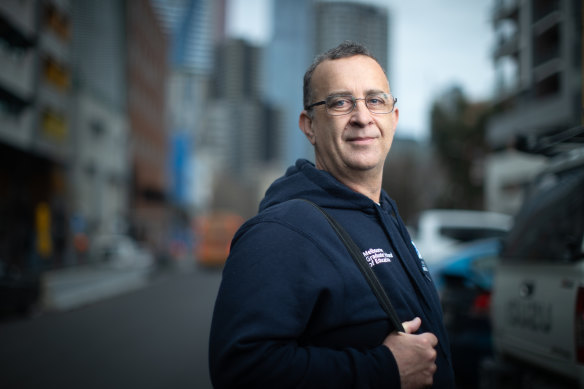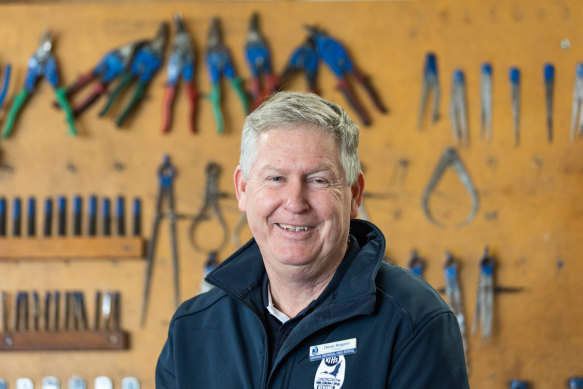Desperately seeking staff: Inside Victoria’s teacher shortage

Mike Flavel had to sell his car to keep working and training as a teacher. By his back-of-the-envelope estimate, this measure should keep his family afloat for the rest of the year. But it will be tight.
Before the pandemic Flavel, 52, was an operations manager for a telecommunications company. But during two long years of lockdowns the single dad found himself loving helping his kids with remote learning. And he was good at it.
Mike Flavel, pre-service teacher at the Melbourne Graduate School of Education.Credit:Simon Schluter
Retraining as a teacher has not been easy, though. He works three part-time jobs, including as a relief teacher. Having given up his previous career to retrain, Flavel – like many other student teachers – is struggling with the requirement that pre-service teachers complete 10 to 12 weeks of placements.
Unlike apprenticeships, placements for student teachers – now known as pre-service teachers – are unpaid.
“I know some people who’ve had to drop out of the course completely because of financial reasons,” he says.
“There’s a shortage of teachers [and] there’s a shortage of good quality teachers. And here we’ve got a cohort of people who want to be in teaching; they love it, and they want to be good quality teachers, but there’s all these barriers in the way that aren’t necessarily in the way for other professions or for trades.”
In 2019, just 51 per cent of undergraduates undertaking teaching degrees finished their courses. Of teaching undergraduates who were contemplating dropping out, one-third nominated the need to do paid work as a factor.
“If we can increase that rate and get more young people who start a teaching degree become teachers, then we’ll go a long way to tackling the teacher shortage,” federal Education Minister Jason Clare said on Thursday.
Paid school placements and accelerated degrees have both been mooted as reforms that could overcome declining enrolment rates in teaching courses.
The shortage is also forcing schools to contemplate novel ways to plug staff gaps.
In eastern Victoria, almost 50 Catholic schools within the diocese of Sale have just agreed to improved working conditions for teachers, including reduced classroom hours and casual rates of pay that exceed those offered in government schools.
Independent Education Union deputy general secretary David Brear said school operators had no choice but to confront teacher workloads.
“Schools and school systems have to ask themselves why there is a teacher shortage,” he said. “Some continue to burn out staff and refuse to change and then wonder, where have all the teachers gone?”
As a disadvantaged country school, Kerang Technical High School is a quintessential hard-to-staff school. But finding staff this year has been something else, says long-time principal Dean Rogers, who has to redo the school’s timetable five times this year to cope with the loss of a large chunk of his workforce.
Five of the school’s teaching staff are no longer available: two have retired, two have left for other schools and one is on medical leave.
“We’re feeling the pinch, big time,” he said. “There just isn’t the staff around, and that’s where we’re at.”
Dean Rogers, long-serving principal of Kerang Technical High School.Credit:Jason South
Rogers is throwing the kitchen sink at getting teachers to the school, advertising and working with teacher agencies, and speaking to a fourth-year teaching student about getting them in to teach early.
But getting fourth-year students into classrooms isn’t easy, despite the obvious need.
Pre-service teachers in their final year of study at an accredited Victorian initial teacher education program can receive permission to teach specific subjects at schools with shortages. They can also fill short-term vacancies caused by COVID-19.
There are hurdles the school and the student must clear to access a student teacher.
To be successful, the applicant must be able to demonstrate that they have appropriate content knowledge of the subject, and the school must provide evidence of a workforce shortage for the position and detail how they will supervise and support the applicant.
Rogers said COVID-19 had created a perfect storm for the profession: teachers who worked the long terms of stop-start remote learning were often burnt-out or sick; older teachers were heading for retirement; and the long international border closure had stopped international teachers flying in.
Daniel Mundy, founder of teacher agency ANZ UK, said recruiting casual relief teachers was so tough his organisation had set up four new recruiting centres over the past six months, in Ireland, Wales, Scandinavia and New Zealand. They also have centres in the UK and Canada.
“We’ve set up eight recruiting centres around the world, but it’s not enough,” he said.
Mundy said getting overseas qualified teachers registered with the Victorian Institute of Teaching was a good quick fix to the teacher shortage.
“I think we’ve recruited about 200 in the last six months, but we are planning on getting 600 to 700 next year and up to 1000 to 1200 by 2025,” he said.
He said there was often between a three to nine-month waiting period between when a teacher applied and when they arrived in Australia.
“There’s a lot that can happen in that duration when you are talking about a big life decision,” he said.
Schools are also madly advertising for staff. An Australian Education Union survey of 242 state school principals, released this week, found 89 per cent are concerned their school will not have enough qualified teachers by the start of the 2023 school year.
New data provided to The Age by job ad giant SEEK shows primary teaching ads in Victoria increased 24 per cent in the three months to July, compared with the same period last year. Secondary teaching ads surged 55 per cent year-on-year, while teaching aid and special need job ads were up 28 per cent.
Clare committed to releasing a national action plan on teacher shortages by December. The proposals include teaching students being paid for their school placements and career changers doing shorter teaching degrees.
But for many, December is a long way away.
Victorian Principals Association president Andrew Dalgleish said there was no quick fix.
“That challenge is still there, that dreaded call on an evening or very early in the morning, then the scramble to try and access a CRT. If we can’t get one we look at our programs, what do we do to see we have teachers in front of children to deliver a quality program?” Dalgleish said.
A new organisation of students, associated with the Australian Education Union and Independent Education Union, has called on governments to pay student teachers during placements.
Oscar Jolly, a teacher who began organising fellow student teachers at the University of Melbourne, said with more than 200 active members the association was the largest union collective of pre-service teachers in the country.
Jolly said the current model forced teaching students to give up or defer their usual paid work during placements, meaning students were losing income – and those who couldn’t afford to lose income were dropping out.
“Easing intense financial stress through paid placements will help us retain thousands of pre-service teachers driven out of the profession,” he said. “It will help secure the future pipeline of teachers.”
AEU Victorian branch president Meredith Peace said the union backed paying student teachers for their time completing placements.
But she said allowing accelerated progression into teaching for career-change professionals risks putting an underqualified person in front of students.
“We need a four-year degree to teach in a public school, and we don’t want to see those kinds of provisions watered down,” Peace said.
“That’s one of the dangers you deal with when you experience a shortage, and it’s incredibly important to maintain quality.”
The Morning Edition newsletter is our guide to the day’s most important and interesting stories, analysis and insights. Sign up here.
Most Viewed in National
From our partners
Source: Read Full Article

